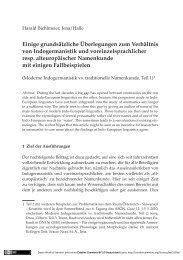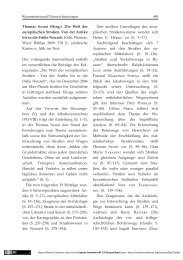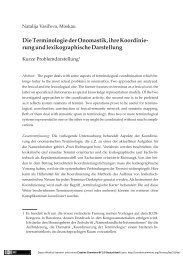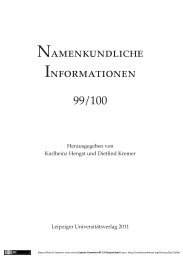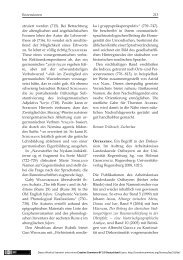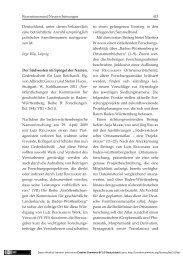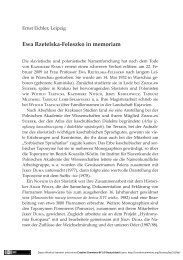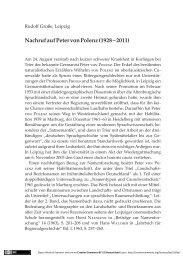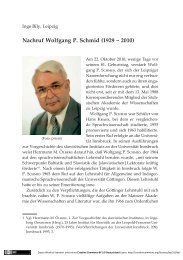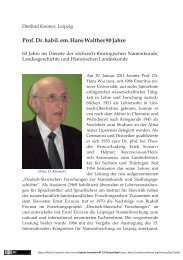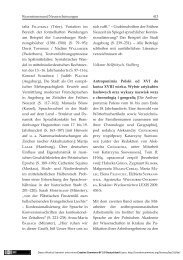Proper Names in the Light of Theoretical Onomastics
Proper Names in the Light of Theoretical Onomastics
Proper Names in the Light of Theoretical Onomastics
Create successful ePaper yourself
Turn your PDF publications into a flip-book with our unique Google optimized e-Paper software.
<strong>Proper</strong> <strong>Names</strong> In <strong>the</strong> <strong>Light</strong> <strong>of</strong> <strong>Theoretical</strong> <strong>Onomastics</strong>123varied systems, such as classes <strong>of</strong> liv<strong>in</strong>g personal names or geographicalnames, an important characteristic <strong>of</strong> <strong>the</strong> structural organisation <strong>of</strong> <strong>the</strong>micro system is <strong>the</strong> <strong>in</strong>tensive usage <strong>of</strong> certa<strong>in</strong> content models, motivationalmodels and word-form<strong>in</strong>g models <strong>in</strong> <strong>in</strong>dividual geographical areas and <strong>in</strong><strong>the</strong>ir historical development. The degree <strong>of</strong> productivity <strong>of</strong> <strong>the</strong>se modelsis reflected <strong>in</strong> <strong>the</strong> frequency <strong>of</strong> <strong>the</strong>ir use. The differences <strong>in</strong> proprial andappellative nom<strong>in</strong>ation relate to <strong>the</strong> fact that onymic and dialect areas donot overlap. Onymic systems, as expressed <strong>in</strong> a term by V. Ma<strong>the</strong>sius, areflexibly stable. Their dynamic character results from a tension between <strong>the</strong>nam<strong>in</strong>g needs <strong>of</strong> socially determ<strong>in</strong>ed identification // differentiation (<strong>the</strong>sereflect adm<strong>in</strong>istrative-legal and more restricted social standards which,however, are not static variables) and <strong>the</strong> nam<strong>in</strong>g capacities <strong>of</strong> a respectivelanguage. <strong>Proper</strong> names act <strong>in</strong> communication as prototypes. The realisation<strong>of</strong> elemental system components, as presented <strong>in</strong> an onymic situation,and <strong>the</strong> mental representation <strong>of</strong> language-users has a dynamic characterand that is why <strong>the</strong> formal onymic system also has a dynamic status.Onymic systems, <strong>in</strong> respect <strong>of</strong> <strong>the</strong> character <strong>of</strong> <strong>the</strong> objects named, manifest<strong>the</strong>mselves <strong>in</strong> a certa<strong>in</strong> way <strong>in</strong> area, time and frequency dimensions.For example, toponymic names <strong>in</strong> <strong>the</strong>ir motivation are permanently relatedto <strong>the</strong>ir location <strong>in</strong> a geographical area. They are termed proprial(or system) areas. System areas have <strong>the</strong>ir time layers and space areas<strong>in</strong> which macrotypes, microtypes and <strong>the</strong> so-called small types <strong>of</strong> localnames are studied. In local names, we observe how nam<strong>in</strong>g standards <strong>in</strong>toponymy react to changes <strong>in</strong> <strong>the</strong> onymic situation. Quite a large role <strong>in</strong><strong>the</strong> stabilisation and modification <strong>of</strong> nam<strong>in</strong>g standards is played by <strong>the</strong>ideological positions adopted by <strong>the</strong> political representatives <strong>of</strong> a stateadm<strong>in</strong>istration. Proprial l<strong>in</strong>gual geography represents a shift from <strong>the</strong>etymologis<strong>in</strong>g aspect; it is one <strong>of</strong> <strong>the</strong> basic work<strong>in</strong>g methods <strong>of</strong> currentonomastics (see Šrámek 1999, 86).The function<strong>in</strong>g <strong>of</strong> anthroponyms and <strong>the</strong> anthroponymic system isperformed externally as part <strong>of</strong> a change <strong>of</strong> named persons <strong>in</strong> <strong>the</strong> classes<strong>of</strong> men, women and (unmarried) children over generations. With<strong>in</strong> <strong>the</strong>sethree classes, <strong>the</strong> reproduction <strong>of</strong> a personal name is realised with eachnew generation. Personal nam<strong>in</strong>g <strong>in</strong>volves not only <strong>the</strong> dynamic whichfollows from <strong>the</strong> need to name new <strong>in</strong>dividuals <strong>in</strong> <strong>the</strong> cont<strong>in</strong>uous exchange<strong>of</strong> generations but, from <strong>the</strong> early mediaeval period, a significantrole is played by <strong>the</strong> way <strong>in</strong> which family relations with<strong>in</strong> k<strong>in</strong>ship groupswas expressed. The development progressed from a system <strong>of</strong> non-



